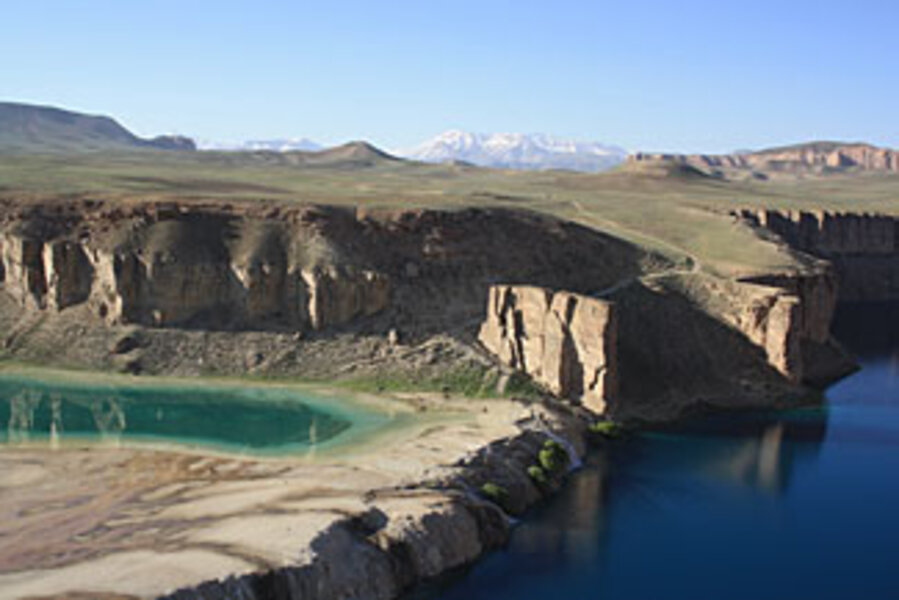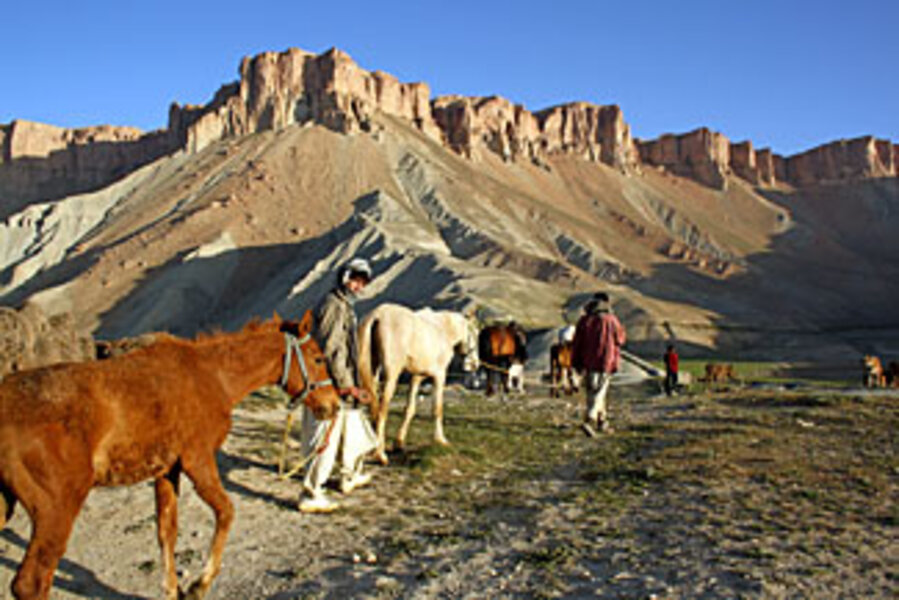Afghanistan's first national park waits for tourists
Loading...
| Band-e-Amir, Afghanistan
It's got the soaring mesas of Canyon de Chelly and Monument Valley, the contrasts of oranges and reds found in the Grand Canyon, and the snow-dolloped peaks of the Rockies – all in one place.
That's how Dennis, a tourist from Colorado, tries to put the beauty of Band-e-Amir in context, as he helps his German friend Lukas (they decline to give last names) pitch their tent by one of the area's famed travertine lakes.
"I've never seen any other lake of that stunning blue," Lukas says.
On June 18, Band-e-Amir will be officially inaugurated as Afghanistan's first national park. International organizations, the Afghan government, and local villagers are all hoping that the designation will inspire more tourists to come to this war-ravaged nation.
The idea may sound quixotic, given the surge in Taliban violence and US troop deployments here. But the park lies in the safest region of the country, in the Baba Mountains of central Afghanistan – a mixed blessing, since foreign donors have focused their help on hot spots first.
The park's fruition has also been hampered by problems that hinder other Afghan development projects, including slow government decisionmaking, tensions between jet-setting coordinators and rural locals, and disappearing money. And, as with other projects, this one seems to be getting in gear just as security is slipping.
"Last year was a particularly discouraging year," says Andre Mann, manager of The Great Game Travel Company in Kabul. "We've decided to give it another year and see what happens. We hope [August] elections stabilize things so that our business can grow."
At its busiest in 2007, his company booked some 300 foreigners on tours of Afghanistan. Last year, the number slipped to 150, and this year he estimates he will only get 80. The other tour operator, Afghan Logistics & Tours, saw a similar falloff from roughly 75 tourists a year to 50 or 60.
Exactly how many tourists visit Band-e-Amir is unknown, with the governor of Bamiyan Province saying 500 last year and aid agencies saying it was thousands. The discrepancy might relate to who is counted as a tourist – many Afghans visit the site, as well as expatriates like Dennis and Lukas, who work in Kabul. The one guesthouse in the park hosts 500 to 800 guests each year.
The potential is much bigger: Crowds thronged here in the peaceful 1960s and '70s.
"We are working to set up the infrastructure to make this sustainable, so it doesn't end up like [overdeveloped] Thailand," says Mr. Mann. "In the '70s it was heading in that direction. The war spared it that, and now we are trying to do it right."
Locals have fonder memories – especially of the money tourists brought. Dennis and Lukas's driver, Ezat Ullah, gets $50 a day to bring visitors here. Other Western tourists here recently, Jerome Mathieu and Berengere Travard, say they spent $80 a day on a hotel and meals.
"Tourism is one of the only industries that quickly brings money to everyone," says Muqim Jamshady, head of Afghan Logistics & Tours.
Where has the money gone?
Residents of the 13 villages around the park are hoping the national park will bring those quick dollars, but that hasn't happened. That's because preservation efforts have proceeded much faster than tourism development.
The views have improved: Shops no longer encroach on the lake, a fuel-leaking motorboat is now banned, and "fishing" with grenades has been quashed. But the new restrictions – which also apply to hunting, grazing, and adding cultivation to nearby fields – have cut into local livelihoods.
Residents are suspicious about where the park fees collected from visitors go. A portion is supposed to help fund local community projects.
"They have not paid a penny. It's collected, but no one knows where it goes," says Muhammad Hussein Azimi, who runs the local guesthouse.
The money is safe in a bank account, says Bamiyan Gov. Habiba Surabi. It cannot be distributed until the Ministry of Finance in Kabul signs off on the revenue-sharing plan. She blames this and the "slow process" of getting the park up and running on the "very centralized" government system. Just getting rid of the polluting motorboat involved a two-year battle between an Afghan vice president and the governor.
'A national park in name only'
Much work has been done by the Wildlife Conservation Society (WCS) using US Agency for International Development funds to preserve the land, survey the wildlife, and manage a broad committee to create the park. But locals have seen little action on the ground. One person from each of the villages received tour-guide training last year, but they don't seem to know what to do next – or even where to meet tourists. One obvious place would be the welcome center, built two years ago by WCS, but rangers say it's used by officials more than by tourists.
"Honestly, it's a national park in name only," says acting park representative Sayed Muhammad Husseini Dartmond. "Even this building you are sitting in, if [aid groups] paid for it, it's not to help us do more: It's just for them to come here for themselves and stay overnight."
The station is no longer used for overnight stays. "We realized it was inappropriate," says Chris Shank, a WCS program manager. The vision is that the station will be a hub for tourists, he says, and there has been "a lag time, no question," in tourist development.
Natural beauty leads to tourists, which leads to income for locals, says Dr. Shank. But, "We've been very clear right from the beginning that there are no guarantees."
The good news is that New Zealand has dedicated money to tourism projects here, and the road linking Kabul to Bamiyan and Band-e-Amir is finally being fixed, widened, and paved. Frustration over the road's neglect erupted last year in a protest.
But even with a good road, news of violence in other parts of Afghanistan may scare visitors away from Bamiyan, where international forces have yet to fire a bullet in eight years.
"If we had stability here, there are rivers to be rafted, so many peaks to hike," Mann says. "But you've got to have peace."






